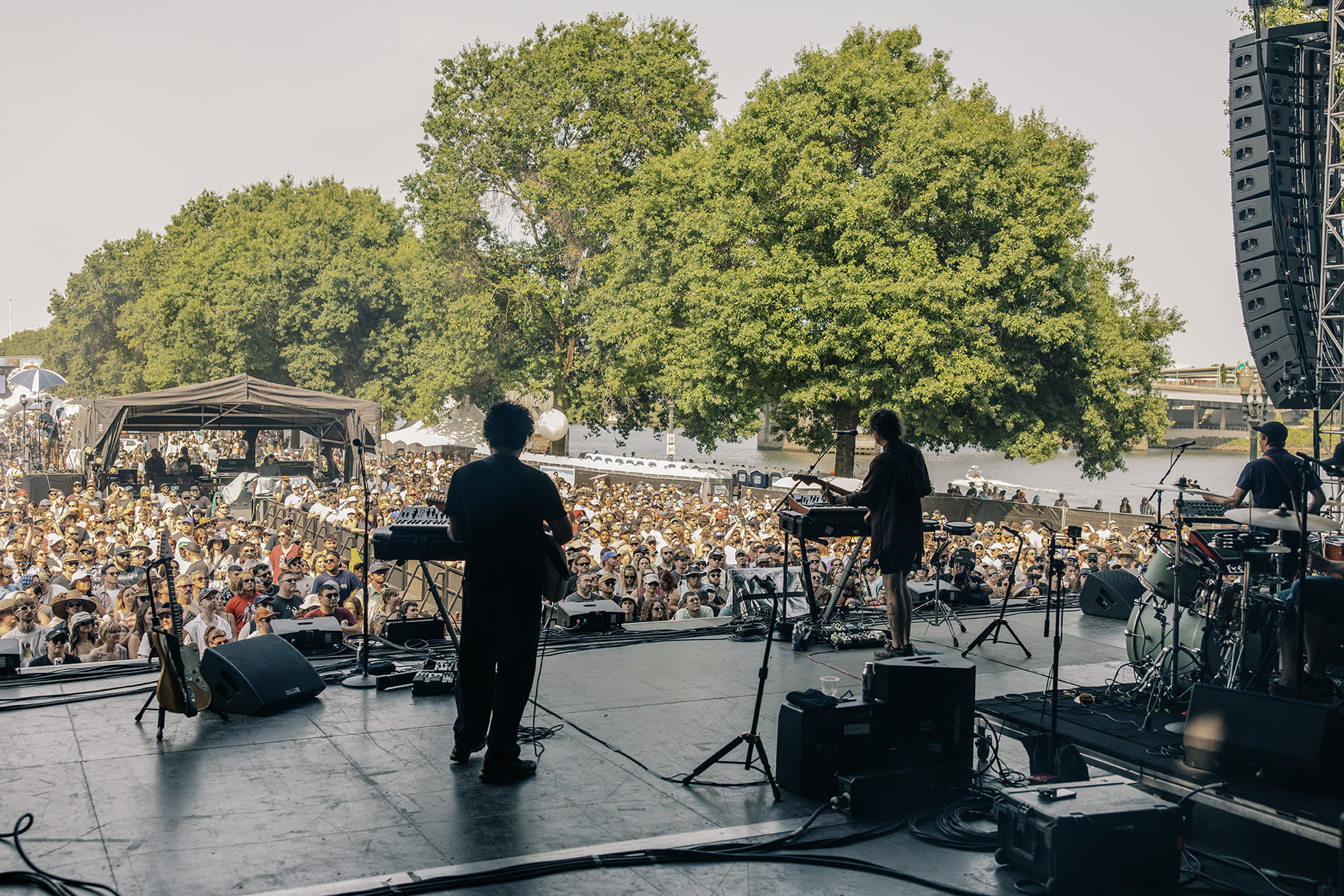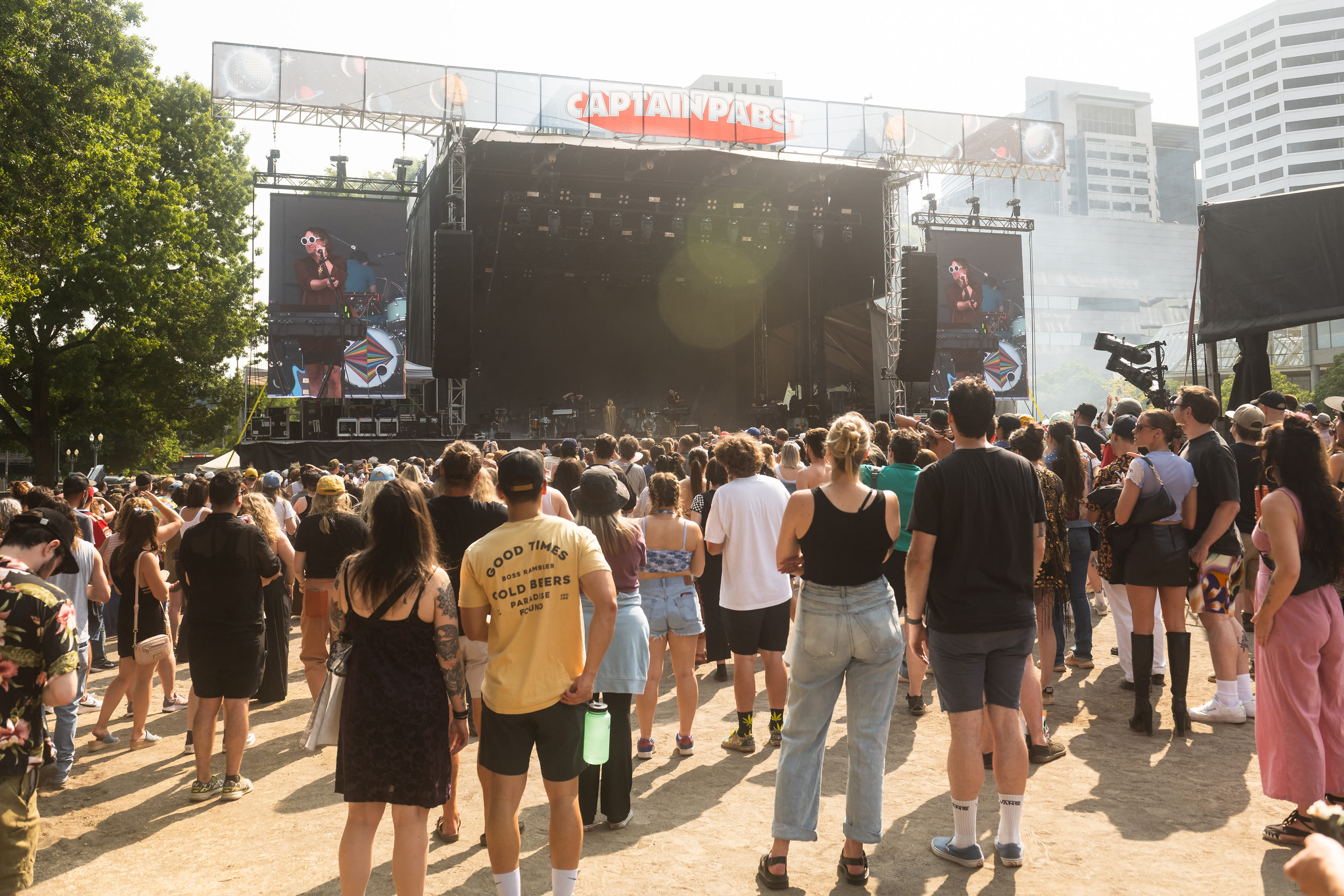
Marketing Portland's Music to the Masses
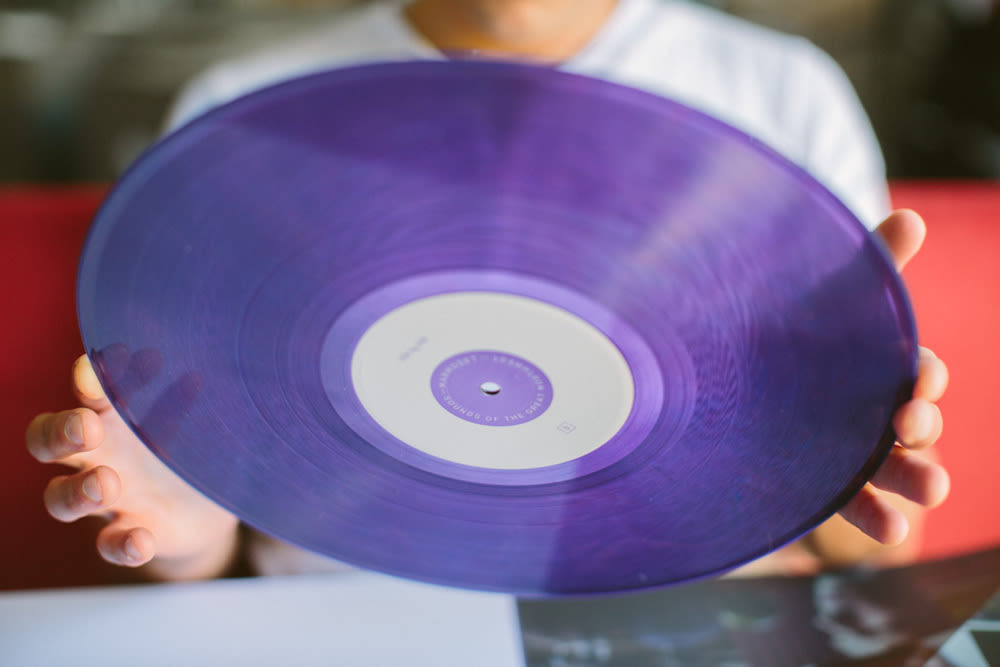
GIVEAWAY
Marmoset, a homegrown music agency, invited twelve local bands to cover a song by one of the other bands. Twelve bands, four days, one studio. With tracks by artists such as Radiation City, Lost Lander, Dolorean, and Kye Kye, the digital album will be released in August on Marmoset's website and iTunes (proceeds benefit Portland's Rock'n Roll Camp for Girls). A limited number of translucent, purple, 12-inch vinyl records will be given to friends, family, and four lucky Portland Monthly readers. This contest is now closed.
Sara Matarazzo spends most of her time on the telephone. In the parking garage on the way to a preview screening of Frances Ha, the recent Noah Baumbach film whose music—classic French cinema songs—she chose and tracked down, her iPhone rings. Rather, it quacks. She answers.
“Hello? Hi. They don’t like the bass line. I’m going to send you exactly what they said. Just remember that you have to make it different.”
On the escalator the phone quacks again. Then again on the mezzanine of the Pioneer Place movie theater. Each call is a composer wanting to talk about a commercial she’s hired them for. Matarazzo is essentially playing interpreter between two cultures that, at the best of times, enjoy an uneasy peace: the creative world of music, and the ruthlessly nitpicky world of marketing. At any given point, the 38-year-old, her sharp features framed by brown hair and offset tonight with raspberry lipstick, is working with some 30 composers, hardly letting her seventh month of pregnancy slow her down. As Matarazzo approaches the theater entrance, one of two sexagenarian women collecting tickets says, “This is probably not what you’re looking for. This is a sneak preview.” With chunky necklaces, dyed hair, and sneakers, they look like the kind of retirees who make a hobby of these things.
“Oh, I worked on this film,” Matarazzo answers sweetly. It’s the second film she has been involved with that’s had a special screening in Portland. Last year, she hosted a large event for Wes Anderson’s Moonrise Kingdom at the Whitsell Auditorium. She also helped out on Star Trek: Into Darkness, she mentions nonchalantly, pointing to a giant cardboard stand-up that looms nearby.
By profession, Matarazzo is known as a “music supervisor.” Marketing companies, brands, and filmmakers hire her to find that perfect song—such as an electronic track by the artist Dabrye that sonically propelled a Motorola commercial in which a sleek room fractures and folds up into a Moto Razr phone. When she can’t find the right song, she hires someone to write it, to order. The string quartet she commissioned from the young composer Nicholas Wright for Nike’s “Find Your Greatness” London Olympics spot, showing everyday athletes around the world, won the Association of Independent Commercial Producers’ award in June for best original music. Often, the tracks she discovers come from Portland’s fertile independent music scenes. She’s placed the swinging rock of Sallie Ford and the Sound Outside in ads for Target and J. Crew, casting the band’s songs farther than any radio play has. Given the otherwise dismal state of the music industry, any of those phone calls Matarazzo relentlessly places or receives could change the life of a starving songwriter or a scruffy band.
This power has helped Matarazzo and a few local colleagues make Portland a fulcrum for a major shift in how the music business works, especially for the kind of independent, edgy, underground artists the city prides itself on breeding. Once, any band or songwriter aspiring to underground or outsider status would have gouged his or her own eyes out rather than appear to be “selling out” in any way. (In the early ’90s, punk-rock partisans conducted an endless debate over whether bands should even allow Universal Product Code symbols to appear on their records.) Now, with album sales decimated by digitization and commercial radio just as boring as ever, many “indie” bands covet jobs writing jingles for corporate commercials, movies, or video games.
“This is an important new source of income,” says Don Gorder, founder and chair of the Music Business/Management Department of the Berklee College of Music in Boston. Indeed, the revenue from such song licensing climbed from a negligible amount in 2008 to $342 million in 2011, according to the world’s leading industry organization, the International Federation of the Phonographic Industry (IFPI). “For some indie labels and bands,” Gorder says, “I would say as much as 30 to 40 percent is coming from licensing music. And they’re going after it wholeheartedly.”
Inside Pioneer Place, Matarazzo finally turns her ringer off and enters the theater. Frances Ha has been her most challenging project to date; the search for the owners of the French songs from the ’60s required digging through obscure French record archives. In tandem with the black-and-white cinematography, though, the music transforms what could have felt like a Girls knockoff into a modern-day fairy tale. As the credits roll, Matarazzo wipes her eyes. “I didn’t know what I was doing in the beginning, but the passion was there,” she says later of her fake-it-till-you-make-it journey to running her own company. “No one can deny when someone is passionate.”

Matarazzo’s path to reinventing the music industry bounced and grew like the beat of a dance track. The daughter of a musician, she worked at her father’s New York record label, Celluloid, before taking off in the ’90s to hopscotch the world as a DJ, playing major raves and parties from Paris to Bangkok. She chose musical aliases in keeping with her identity as a self-described nerd, performing as Doomer, a tribute to the comics villain Dr. Doom, and Sara Walker, after the mammoth vehicles in Star Wars. But the advent of her thirties kindled an urge for stability (and health insurance), so she applied for a job at the New York–based global advertising agency Ogilvy & Mather in 2004.
“She came across as very intuitive, personable, and had great taste, which is paramount to what we do,” says Karl Westman, the senior-partner executive music producer who hired her. She worked with clients like American Express and IBM. Westman highlights her work with Fanta as “groundbreaking” for creating a sonic brand identity that continues to this day.
At the time, the general practice in advertising was to find a band whose sound fit the spot, and then to hire a composer and studio musicians to emulate it. (For years, Matarazzo says, all she heard was, “We want it to sound like Coldplay!”) Her epiphany came in 2005, while working on the Motorola campaign. The Ogilvy creative team suggested copying the sound of an electronic artist named Evac, recounts Matarazzo. “I said, ‘Let’s call him.’” She tracked him down in Kansas City, hired him to do an original piece of music, and paid him handsomely for it.
Coming from the music industry, where record labels take a princely cut from many artists, into an advertising industry drunk with money to pay “talent,” Matarazzo’s realization was simple: artists could do very well through licensing and compositions.
Ads, of course, have long featured musicians. Coca-Cola had Ray Charles as early as 1965. Pepsi had Michael Jackson in the ’80s. But for the most part, big brands wanted only superstars, seldom entrusting their products’ futures to unknowns. Meanwhile, indie musicians valued their street cred over commercial tie-ins.
That is, until 1999, when the electronica artist Moby licensed all 18 tracks from his album Play hundreds of times, exploding into the mainstream like an aural Trojan horse. From the American Express ad in which Tiger Woods uses Manhattan as a golf course to the movie The Beach and episodes of The X-Files, Moby’s songs have been everywhere. Consequently, the album sold more than 12 million copies worldwide, redefining “commercial rock.” The same year, Nick Drake posthumously landed in a Volkswagen commercial, catapulting the forgotten artist to fame. In 2000, Portland rockers the Dandy Warhols’ “Bohemian Like You” soundtracked a flashy Vodafone commercial and became a summer anthem in Europe and Australia.
“I have no idea why Moby decided it was no big deal,” Zia McCabe of the Dandy Warhols says, “but for us, we realized without fitting neatly into any commercial radio categories, this was a great way to not only get exposure but to get paid for it.” After barely making a thud in 2000, the band’s album was rereleased in 2001 and the title song peaked at no. 5 in the UK.
What started as a trickle turned into a stream with Apple’s mid-2000s iPod commercials, which became known for breaking lesser-known bands. After soundtracking an ad, Feist’s “1234” hit no. 28 on Billboard with 78,000 downloads in a week, and CSS’s “Music Is My Hot Hot Sex” became the highest US charter by a Brazilian artist (no. 63). “It’s probably only in the last five years or so when we really started to see it taking off,” says Berklee’s Gorder. “Ad agencies started recognizing that this millennial generation is so into discovery, and they really began searching out indie bands.”
By that time, Matarazzo was already on the vanguard. “She really has a knack for matching the band to the job in a way that’s appropriate to the storytelling at hand,” says former boss Westman. “It was very apparent early on that she was going places.”
One place was away from Ogilvy. While working on an American Express spot that showed the director Wes Anderson strolling through one of his chaotic shoots, she met Randall Poster, an industry legend hailed by Salon as “the man with perfect taste” for his supervision of all of Anderson’s films. “Wes and I insisted that we were going to get the original score from François Truffaut’s Day for Night,” says Poster. “The client and the agency were a bit appalled at our resolute commitment to doing that. Sara was the only person on the other side who was cheering us on.” Poster, working to expand his company, Search Party, from film into commercials, offered her a position in 2008. Matarazzo quickly ascended to managing director while working on movies like Anderson’s The Fantastic Mr. Fox, commercials, and TV shows.
In 2010, Wieden & Kennedy hired Matarazzo’s husband, Dan Kroeger, as a copywriter. She relocated to Portland and, because Poster didn’t want to lose her, set up a satellite office of Search Party. While operating out of her apartment, she landed a gig working on a W&K Christmas campaign for Target that involved six commercials and an entire album of original holiday music. She immediately set off on her mission to hire bands she loved.
Matarazzo joined a growing cluster of Portland-based tastemakers who operate a bit like record-label talent scouts did in the music industry’s glory days: picking and choosing bands, making and breaking careers. Founded in 1996 by composer Paul Anthony in his University of Oregon dorm room, Rumblefish, for instance, began by repping local musicians and placing music for the likes of The Sopranos, The Real World, and Chevrolet. But since moving to Portland in 2001, Anthony has shifted to what he sees as the future: licensing music for user-generated content. Rumblefish created an iTunes-style program that lets anyone choose songs to accompany, for example, their own YouTube videos. The selection includes big names like Miles Davis and indie acts like Seattle rapper MG! the Visionary, who helped popularize the “planking” craze (lying rigid like a plank on any number of objects) with a viral video. The company now licenses more than 25,000 songs a day (the artist gets half the fee), supporting a stable of what Anthony calls “middle-class musicians.”
Other companies are setting up shop all the time. This month, Marmoset—started in 2010 with a goal of tapping into the Northwest’s musical talent pool—will launch the first licensing website geared specifically toward independent filmmakers, says cofounder Ryan Wines. The national agency Beta Petrol started a satellite here, and a collective of musicians called Pacific Soundtracks opened in June. “Part of it is the Portland appeal and brand,” Wines says, explaining that it was much easier than he’d expected to land a Bud Light Super Bowl campaign. “You go to New York or elsewhere and say ‘Portland music,’ and everybody listens.”
On a Saturday night in May, Sallie Ford and the Sound Outside are burning through the song “Party Kids” in the vaulted main room of Matarazzo’s office. “’Cause I know where the party can be found,” Ford wails with a soulful growl, bending her peppermint guitar while the Sound Outside surges behind her. A crowd of Portland music luminaries fills the kitchen, with its chalkboard walls and kegerator, showering birthday wishes on Seann McKeel, a longtime local booker and events producer.
Matarazzo met McKeel’s husband, Chris Funk, a multi-instrumentalist in the Decemberists and Black Prairie, shortly after she moved to Portland. He had been trying to break into composing for commercials. She gave him his first shot. Matarazzo wanted an office and both of them wanted a studio, so they teamed up. The result: an open loft space with offices on a mezzanine and a recording studio that rises like a white glacier of abstract geometry but with rustic wood accents on the inside, thus earning it the moniker “the space barn.”
At first, Funk worked on his own projects, recording and producing local bands. With one of Portland’s most extensive music Rolodexes, he’s the kind of producer who can sweet-talk internationally touring bands such as Blind Pilot to play to an audience of children at his regular You Who! event, or who, with a couple of calls, can book one of the most star-studded local music events ever: k.d. lang, the Decemberists’ Colin Meloy, and Death Cab for Cutie’s Ben Gibbard in a benefit at the Aladdin Theater for Children’s Cancer Association. As Matarazzo walked down from her office with questions like “Where can I get Tuvan throat singers?” Funk organically assumed a producer role with Search Party. “I was looking for a way to make music in Portland,” he says, “without the pressure of being on the road all the time.”
The two have been able to offer a similar hope to a range of Portland bands. Last year, in Matarazzo’s third partnership with Paul McCartney’s music publishing company, MPL, they put together the Starbucks album Holidays Rule. (While McCartney doesn’t own the Beatles catalog, it turns out he owns a formidable Christmas library.) Inspired by Sallie Ford’s take on “Sleigh Ride” for Target, they placed local acts Y La Bamba, AgesAndAges, and Black Prairie (featuring Ford) alongside McCartney and radio stars like the Shins and Fun, hitting 42 on the Billboard charts. “It has been strange to have our music in commercials—and believe me, I’ve gotten crap from friends about it,” Ford says. “It has also been where we made the most money from music.”
Indeed, indie bands earn four to five figures for a spot, says Berklee’s Gorder. While significant for the musicians, it’s a bargain rate for advertisers, who have to pay six digits for established pop stars. And as commercials increasingly bring in film directors and strive to be slick mini-movie productions, the appeal of under-the-radar acts is growing.
Wanting to be her own boss, Matarazzo branched her Portland office off from Search Party in April to launch Walker, concentrating more on developing original music and coming full circle back to her DJ name (although she still frequently works with Poster). McKeel’s birthday party was the first large event hosted in the renamed office. As Sallie Ford wrapped up and Funk started inviting the various musicians in the room to play with him—and Matarazzo dodged his entreaties to sing (was it Huey Lewis?)—the camaraderie the two have created with Portland’s music community resonated like the heartbeat of the bass drum. “We’re feeding a community of musicians,” Funk says. “Sara’s so generous when it comes to taking a shot on a rookie. Her presence has spawned a new form of currency for musicians in Portland.”
Indie Cred Unblemished | Three bands Walker likes to work with
Sallie Ford and the Sound Outside
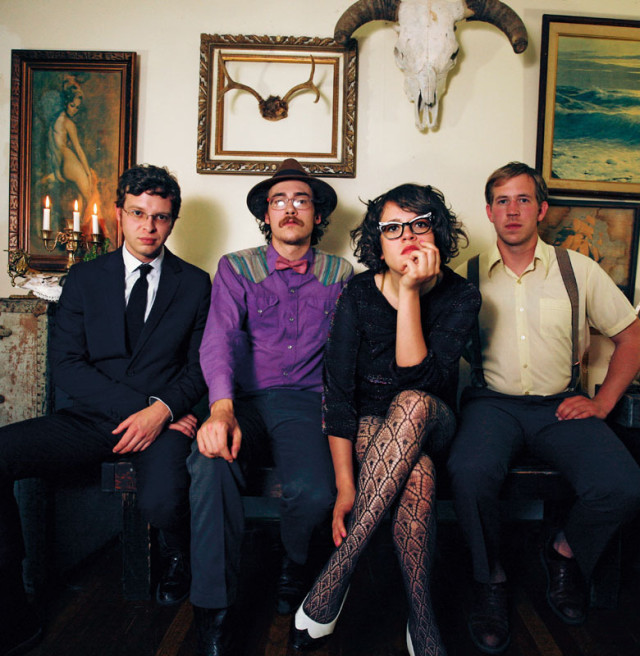
Image: Courtesy Liz Devine
“Sallie inspired the Starbucks holiday album,” says Matarazzo. “She did this version of ‘Sleigh Ride’—a song I’ve heard forever, but now it’s good.” Playing raw and raucous rock ’n’ roll that’s simultaneously modern and a throwback to the ’50s, Ford and her band have charmed audiences everywhere from the Bonnaroo festival in Tennessee to The Late Show with David Letterman to Europe—they tour France for weeks at a time.
Matarazzo has placed Ford in Target and J. Crew campaigns, which led to the band’s songs appearing in The Good Wife, Vampire Diaries, and a number of independent films. “They’re very selective with licensing,” Funk says. “They’re not just like, ‘We could make 100 grand right now.’ They’re like us: they pick and choose.”
↓The music video for Sallie Ford and the Sound Outside's first single, "I Swear," off their debut album Dirty Radio
Y La Bamba
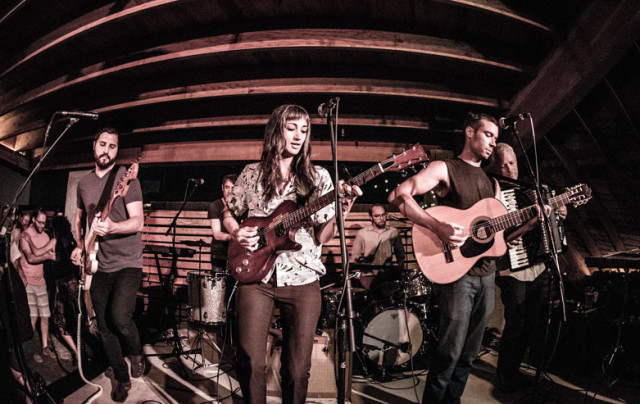
Image: Courtesy Todd Walberg
“I love that she’s modern, she’s a strong woman, and she comes from a Latin background,” says Matarazzo about Luz Elena Mendoza, the lead singer of the hypnotic, Latin-inflected folk-rock band Y La Bamba. “You’ll be at a show, and all of a sudden she’s singing something in Spanish. And it’s not [just] for a certain market, and that’s great.”
After hearing Mendoza sing, Funk produced the band’s first album, Lupon, pro bono. He recently recorded and produced its EP, Oh February, in Walker’s studio. Matarazzo and Funk placed the band’s adorable “Señor Santa (Mister Santa)”—a Latin-spiked, holiday rewrite of “Mister Sandman”—on the Starbucks compilation. “That album has been giving us so much exposure,” Mendoza says. “Chris and Sara believe in the spirit of music. They get it.”
↓Y La Bamba's newest video, "Ponce Pilato," from its album Court the Storm, featuring the Olivia Darlings and the M.A.C. synchronized swimming team in the Red Wood Forest, Oregon Coast, and the Puget Sound
Chromatics
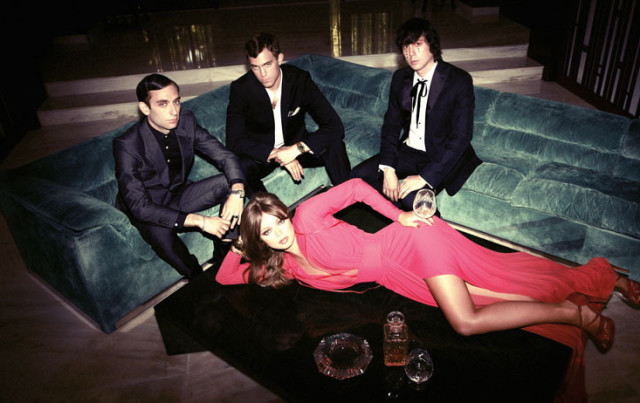
Image: Courtesy Richard Bernardin
Actor Ryan Gosling and director Nicolas Winding Refn kept Chromatics’ 2007 album, Night Drive, on repeat while working on the film Drive. After the electro-pop trio’s gig in Los Angeles, they approached band member and producer Johnny Jewel to compose their film’s soundtrack. In a classic Hollywood tale, the producers ultimately pushed Jewel out for a veteran composer, including just one Chromatics’ song on the soundtrack. But Jewel countered with a cinematic, two-hour, noir-electro album on his own label (Italians Do It Better) titled Themes for an Imaginary Film, expanding and altering his score.
“He created this genre that people point to when they’re throwing out creative ideas, which is not easy to do,” says Matarazzo. She’s had Jewel and Chromatics compose several songs for potential projects, although none have landed yet. “I think they push limits. Once I become obsessed with you, it’s hard to shake.”
↓"Lady" from the Chromatics' 2012 album Kill for Love
